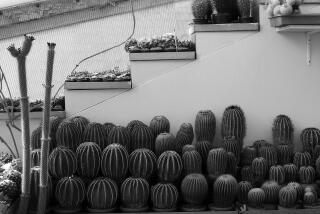Carp Caper : Case of Missing Descanso Gardens Koi Is Still Unsolved
- Share via
Something fishy is going on at Descanso Gardens in La Canada Flintridge. Employees say about 60 koi--which look like oversized goldfish and glide gracefully through Descanso’s ponds and streams--have disappeared in the past three months.
At first, officials suspected that raccoons and blue herons, two natural predators that prowl the Los Angeles County-run gardens, were feasting on the expensive Japanese fish. One koi dealer said Descanso’s collection probably included specimens each worth “thousands of dollars.”
But recent events suggest that the real culprits may be higher on the evolutionary ladder.
On the night of June 15, Crescenta Valley sheriff’s deputies said they received a tip about two men loitering around Descanso with a pail full of water. A witness told deputies that inside the pail swam a large, dark-gray fish.
Although the two fled by car, sheriff’s deputies said they traced the vehicle to a Glendale resident whose backyard held a pond full of koi.
But identification proved a murky business. Ron Lavaneri, a Descanso grounds supervisor, said he thought the Glendale koi were smaller than the missing Descanso fish. Besides, “it’s not like birds where we can tag them,” he added.
No charges were filed, and the case was closed for lack of evidence.
Descanso’s koi thefts are believed to be the third in six months in Southern California. Fountain Valley police reported a theft of about 300 prize-winning fish, each worth up to $1,000, from a private backyard in May, and Torrance police reported a similar theft of about 55 fish in December of last year.
In those cases, police said, the burglaries were committed by professionals who knew the value of the fish. The crimes, however, could not be linked. The thieves were never identified, and no arrests were made.
Philip Ishizu, a San Gabriel koi breeder and past president of the Associated Koi Clubs of America, said there is a growing black market for the fish because of their increasing popularity. He said stolen koi may be transported to other states and sold to unsuspecting buyers.
Locally, it is often hard to resell stolen fish because they have identifying markings that most collectors recognize, he said.
Descanso’s koi, on the other hand, are not as well-known. The ponds are stocked with privately donated fish, and officials are now trying to replenish the diminished koi cache. It is down to about 50 from about 180 earlier this year.
Gardens officials said that 60 to 70 koi died about three months ago when maintenance people pumped in local well water that had been treated with chemicals that proved fatal to the fish. The fish inhabit a series of eight ponds and streams that meander beside a pagoda and under footbridges.
If this seems like much ado over a glorified carp, consider the lineage and long history of the koi:
Introduced to the Orient by Genghis Khan in the 13th Century, koi were bred selectively over the years to enhance color, hue and pattern. They were prized throughout Asia as good luck symbols and revered by collectors for their brilliant platinum, red, blue, yellow and black beauty. The ornamental fish is a member of the carp family.
Koi--pronounced “coy” and meaning “living jewel” in Japanese--can grow up to five feet long, although 30-36 inches is more typical, Ishizu said.
Jewels don’t come cheap. The record is $140,000 for one fish, Ishizu said. Pets may also outlive masters--100 years is a typical life span, and Koi USA, a trade publication, once devoted an obituary to a 214-year-old red carp.
Ishizu, who has been breeding and importing koi since the late 1950s, said the Southland koi industry has grown tenfold in 20 years. He raises about 100,000 fish annually and sells most of them for $5 to $500, although some command $10,000 to $15,000, he said.
To prevent any more disappearances at Descanso, security has been increased, with two groundskeepers who live on the premises now patrolling regularly at night, said employee Don Graff.
Lavaneri said the disappearances first were blamed on local wildlife. But animals would leave behind tails and scales if they had eaten the fish, and the Descanso supervisor said he recalled “maybe one or two,” but not 60 gnawed remains.
Since last month, however, raccoons and herons have been cleared of major wrongdoing.
Said Graff: “When we heard about this fellow with the pails, it made us think it wasn’t the wildlife.”
Times staff writer Penelope McMillan contributed to this story
More to Read
Sign up for Essential California
The most important California stories and recommendations in your inbox every morning.
You may occasionally receive promotional content from the Los Angeles Times.













